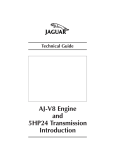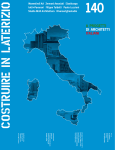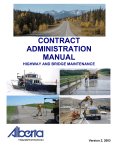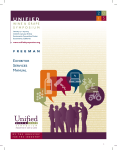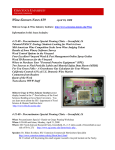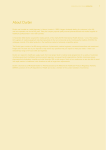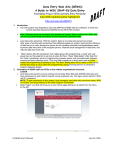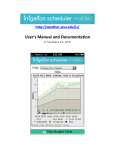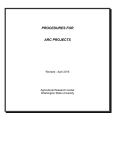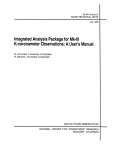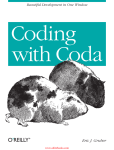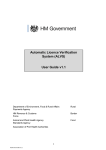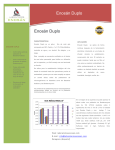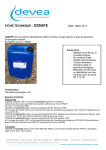Download Fall 2013 - Washington State University Viticulture and Enology
Transcript
Viticulture and Enology Extension News Washington State University FALL 2013 CONTENTS VITICULTURE Mites and Inmates.............. Page 2 Sap and Bud Break............. Page 3 Irrigation Scheduler........... Page 4 Resources....................... Page 5 ENOLOGY Wine Micro Update............ Page 6 NOTE FROM THE EDITOR If we have learned anything from this vintage, it is that timing is everything. Whether it is the timing of heat accumulation, the timing of precipitation, the timing of spray applications, or the timing of harvest, we are at the whims of Mother Nature’s personal task-list. Luckily, through experience and research, we have learned which times in the growing season are ultra-critical, which management practices can be utilized to help minimize negative effects, and which events are unavoidable. In this issue of VEEN, we have a few updates on just that: the timing of different practices. After learning about mite research in Washington, read up on how the timing of water influences vine bud break, followed up with an update on the new and improved Irrigation Scheduler Mobile, designed to help you determine the timing of irrigation. We also have a brief update from the Wine Microbiology lab in Pullman, with a discussion on managing Brettanomyces in wine; and of course, timing of additives and temperature play an important roll! Full of different resources, we hope you enjoy this Fall issue of VEEN! Michelle Moyer Viticulture Extension Specialist WSU-IAREC OTHER NEWS Australia Tour................... Page 6 Call for Info.................... Page 7 Calendar of Events .......... Page 7 FIND US ON THE WEB: www.wine.wsu.edu/research-extension EDITOR Michelle M. Moyer, PhD WSU Extension programs and employment are available to all without discrimination. Evidence of noncompliance may be reported through your local WSU Extension office. Information when you need it. That is the power of the internet! Visit the WSU Viticulture and Enology Research and Extension website for valuable information regarding research programs at WSU, timely news releases on topics that are important to your business, as well as information regarding upcoming workshops and meetings. It is also a valuable site for downloading our most recent Extension publications, in addition to archived articles and newsletters you can print on demand. Find quick links to AgWeatherNet, the Viticulture and Enology Degree and Certificate programs, as well as to other Viticulture and Enology related resources. Find us on Facebook Go to: www.facebook.com/WSU.Vit.Enol.Ext and “Like” the page! 1 Mites and Microscopes: Inmates helping with IPM By David James, WSU-IAREC At the turn of the 21st century, when most people were concerned about ‘Y2K bugs’, Washington grape growers were spending a great deal of time and money combating a different pest: spider mites. At that time, pest management for other insects besides mites often included the use broad-spectrum (BS) insecticides. While effective at killing the target insect, these products also had adverse effects on insect predators in the vineyard. The loss of vineyard insect predators, which preyed on spider mites keeping population explosions under control, resulted in regular spider mite outbreaks. When the BS insecticides were replaced by more selective materials in the early 2000s, insect predators reestablished, and spider mite outbreaks curtailed. But natural systems are a constantly changing environment. In this new insecticide-minimized setting, a different mite population developed: rust mites. After causing panic for a season or two, natural predators and sulfur restored calm. Since then, it has been fairly quiet on the mite front except for some ‘odd’ occurrences of ‘strange’ mites we didn’t know lived on Washington grapevines. It was about that same time that Washington State University did a detailed survey on grapevine mites (2001-2002). Of course, a lot can happen in 10+ years, especially in the rapidly expanding Washington grape industry. It was obvious that another mite survey was long overdue. However, the trouble with mites is that they are very tiny. To conduct a mite survey, you need to collect a lot of leaves and spend many hours peering down a microscope recording, and counting, what you see. So to be effective at conducting Inmates at the Washington State Penitentiary, in Walla Walla, WA are providing the muchneeded help in the WA grape pest survey. Photo by Lorraine Seymour. this survey, and to do so in a timely, cost-effective manner, scientists at WSU-IAREC got creative, and were able to recruit trainable, dedicated, enthusiastic workforce to the world of grapes, leaves and the insects and mites that call them home. This workforce is highly motivated with unlimited time for work and takes great pride in doing a good job. They also work for “free.” Who is this workforce? They are a select, small group of inmates or ‘offenders’ residing at the Washington State Penitentiary (WSP) in Walla Walla, WA. These inmates were trained this summer to recognize, identify, and enumerate all arthropods on grape leaves, including mites. Peering in on the microscopic world likely gives our offenders a new perspective on their lives, just as their experience last year did with rearing butterflies. Doing meaningful tasks like these, gives the offenders a much needed sense of achievement and purpose, which in turn helps with prison harmony and sustainability. It is a win-win; win for researchers, inmates and the grape industry! To date, our surveying has shown generally small populations of spider and rust mites, and a healthy number and diversity of predators. This data has largely originated from the new ‘lab’ at WSP. It is still early in the survey, and the new workforce is still learning, but the signs are good that we are creating some valuable entomological expertise at WSP that will benefit WSU and the Washington grape industry. Detailed results will appear in a future issue of the Viticulture and Enology Extension News. NOT RECEIVING WSU V&E EXTENSION EMAILS? Go to our website: http://irrigatedag.wsu.edu/subscribe-to-email-lists/ This service allows you to customize the information you receive. Choose from topic areas, including: Tree Fruit (apple, cherry, stone fruit, nursery, automation/mechanization), Grapes (juice, wine, table, winery), Other Small Fruit (blueberry, raspberry), Vegetables (potato, onion, sweet corn, peas, carrots, other vegetables), Cereals/Row Crops (wheat/small grains, corn [grain and silage], dry edible beans, alternative crops), Forages (alfalfa, timothy, other grasses/legumes, mint), Livestock (cattle, swine, sheep, goats, pasture management), Ag Systems (high residue farming, soil quality/health, organic ag, direct marketing, small farms), Water and Irrigation (center pivot irrigation, drip irrigation, surface irrigation, water availability/rights). 2 Spring Sap Flow: The Role of Soil Moisture in Bud Break By Hemant Gohil, WSU-IAREC Scant rainfall during winter or early spring can result in stunted shoots and poor fruit set in grapevines. Crop losses of up to 50% have been observed in some vineyards after a dry winter. That is what Markus Keller, Professor of Viticulture at Washington State University, observed in 2005, after an unseasonably dry dormant period. However, when he compared vine growth in a vineyard which did not receive pre-bud break irrigation to a vineyard nearby which did, he noticed that the irrigated vineyard had more even bud break and superior shoot growth; clearly the effects of a dry dormant period could be mitigated with irrigation. According to Keller, “positive root pressure” in grapevines results from remobilized, stored nutrient reserves that are released into to the water-conducting tissue of the vine (xylem). This raises the osmotic pressure in the xylem, causing the roots to draw more water from the soil, thus pushing the subsequent water and nutrient reserve solution (sap) to the canes. That pressure needs to be released somewhere, and is typically in the form of sap bleeding from pruning wounds (Figure 1). If the soil is too dry, root pressure may not develop and as a result much needed water is not available to growing tissues. Are there alternative, natural routes that this pressure can be released, such as through the breaking of buds and the growth of shoots? In other words, is sap flow related to bud break timing and speed? Starting in 2011, Keller, along with graduate student Colin Lee, initiated studies using potted Vitis vinifera ‘‘Merlot’ vines to see if there was a relationship between soil moisture content and subsequent plant development. This study continued in an expanded form in 2012, conducted by Giulio Carmassi, a visiting student from Italy, incorporating different soil types that were representative of eastern Washington. These included a sandy loam from Prosser, WA and loamy sand from Paterson, WA. Going into 2013, the trial was once again expanded, including a gradient of different soil moisture content in the two soil types. The gradients included field capacity (FC) to permanent wilting point (PWP). At FC, the soil has the maximum amount of water it can hold; any additional water is usually lost to deep percolation or run off. If a soil is near the PWP, plants have limited ability to extract water from the soil, and can potentially suffer irreversible damage to the plant (i.e., die). In loamy sand, FC is 15% water content, and PWP is 7% water content. In sandy loam, FC is 23% water content, and PWP is 11% water content. In this experiment, the soil moisture gradients tested were at 1% intervals between FC and PWP. Those levels of soil moisture were maintained through the trial. The plants were then tested for their ability to bleed, and for the quantity of sap they could produce (Figure 2). Bleeding sap was monitored post bud break to determine if vigor (i.e., the rate of shoot growth, total leaves produced, and fruit set) was correlated with the rate of Figure 1- Sap commonly “bleeds” through pruning wounds in sap flow. the early spring, and is a sign of adequate vineyard soil moisture content. Photo by Michelle Moyer. Figure 2- Sap was collected from vines going through pre-bud break to bud break stages. Photo by Hemant Gohil. Soil Moisture Influences Early Season Growth. Sap flow started almost immediately (within 1-3 days) in vines that were irrigated to FC. This was followed by rapid and uniform bud break, and shoot growth. In vines maintained near PWP after transfer from cold storage, delayed bud break occurred, and sap flow was not observed. Interestingly, preliminary tests showed that if vines that were initially maintained at PWP were watered back to FC (before the buds died), they would resume normal bud break and shoot development. Shoot growth and sap bleeding rate were strongly correlated with soil moisture in both soil types. Shoot vigor (elongation and leaf expansion) was the greatest when soil moisture levels were at FC to 2% less than FC (i.e., 1315% for loamy sand, and 21-23% for sandy loam). When soil moisture declined, vine vigor declined and fruit set also declined. Overall, vines in soil that was near PWP (i.e., 7% water content in loamy sand, continued on Page 5 3 Irrigation Scheduler Mobile: New and Improved! By Troy Peters, WSU-IAREC Irrigation Scheduler Mobile is a simple, easy-to-use web application for irrigation scheduling. It is formatted for use on any smart phone as well as on any web browser (http://weather.wsu.edu/ is). It automatically pulls crop water use estimates from weather networks, and does a simple soil water balance to help estimate current soil water content (Figures 1, 2). This can be used to help you make decisions on when to irrigate, and how much to apply. Thus far, the Irrigation Scheduler Mobile has been well-used, with over 800 registered growers, who have set up over 1500 fields. • • A one-week, crop-water-use forecast for irrigation decision planning. • Modifications for water use in hay-cropping systems. It can account for hay cutting by having cutting dates as an input. • Outputs include both hours of irrigation run time and inches of applied irrigation water. Simple calculators are included to help you calculate your irrigation application rate. We have made improvements to Irrigation Scheduler Mobile to make it even more intuitive and user-friendly. We have also added many features that you were asking for, including: • A full page version for use on the main AgWeatherNet (weather.wsu.edu) site. Functionality with weather data from AgriMet; making it useful for all growers in the west instead of just Washigton growers. • Correction factor for vineyards and orchards that do not irrigate inter-row spaces. • Push updates or notifications can be sent as either an email or as a text (SMS) message to your phone. These can be delivered daily, or only when the soil has dried below a level that you specify. View the updated Irrigation Scheduler Mobile at: http://weather.wsu.edu/is/ creasing water use, pumping power use, labor costs, and fertilizer use. Irrigation scheduling can simultaneously decrease potential damage from run-off or leaching of water containing pesticides, nutrients, or sediment. In short, everybody wins! If you use a smart phone, you already have what is necessary to get started; if not, power on your computer and give it a try! Irrigation Scheduler Mobile was developed by Troy Peters, the WSU Extension Irrigation Specialist in collaboration with Sean Hill, AgWeatherNet Programmer, and Gerrit Hoogenboom, AgWeatherNet Director. • Easy transfer of field settings from one location set-up to another. When adding a new field you can copy settings from another field; useful if setting up multiple similar fields, or setting up the same field in a new year. • Use reporting for the number of days you use the tool to view or edit the data for your fields. • In-application help pages for every screen as well as a full user’s manual. Figure 1- Irrigation Scheduler Mobile can be used to help identify soil moisture content, which is adjusted based on soil type and weather conditions. Irrigation Scheduler Mobile is a simple way to significantly improve your irrigation water management. Improved irrigation scheduling can help you increase crop yields and quality while de4 Figure 2- Irrigation Scheduler Mobile has multiple features that allow you to compare and contrast water use and availability at each of your vineyards. Building References: Vit. Extension Publications Even with the 2013 harvest in fullswing, it is not too early to start thinking about next year. WSU has several Extension publications and website reference points that can serve you in your vineyard management decisions for 2014. Below is a highlight of just a few of these publications. More information, as well as links to additional resources, can be found at the WSU Viticulture and Enology Research and Extension website: http://wine.wsu.edu/ research-extension/ . GRAPE PEST MANAGEMENT GUIDE FOR GRAPES IN WASHINGTON (EB0762) This annually-updated guide is released in March. Containing information on registered products for weed, insect, disease, and nematode management in WA, this guide is a must-have for every grape grower. It also has information of nutrient management and sprayer calibration. Links on ordering or downloading this guide will be made available at: http://wine.wsu.edu/researchextension/plant-health/ . FIELD GUIDE FOR INTEGRATED PEST MANAGEMENT IN PACIFIC NORTHWEST VINEYARDS (PNW644) This new guide addresses the critical need in understanding IPM by providing commercial growers, consultants, field and extension personnel, and other pest managers with straightforward, science-based information on identification and control of the region’s insect and mite pests, beneficial arthropods, diseases, and weeds affecting wine and juice grapes. The heart of the guide describes individual pests (insects/mites, diseases, nematodes, and weeds) and disorders, along with recommendations for their management. Users will find themselves turning frequently to the 240 annotated color images, as well as referencing the color-coded and indexed details on integrating pest management with other vineyard tasks. A link to order this guide is at http://wine.wsu.edu/ research-extension/plant-health/ . New to Viticulture? Check out: eViticulture.org eViticulture.org is an Extension clearing house for all things viticulture. Populated with resources and references produced by university Extension specialists across the country, this resource provides quick factsheets on the basics of viticulture production, with links to more in-depth publications written in practical terms. This online resource is perfect for students, those just getting started, and as a refresher for those who have been in the industry. After harvest, grab a glass of wine and check it out! Spring Sap Flow: The Role of Soil Moisture in Bud Break continued from Page 3 and 11% water content in sandy loam) had very poor growth, or neared death; however, vines at 1% above the PWP (i.e., 8% water content in loamy sand and 12% in sandy loam) survived although inflorescence abortion was seen (Figure 3, inset). This study will be continued in 2014, to see when drought stressed vines should be watered to prevent long-term detrimental effects. In other words, at what point can vines at PWP be watered to FC and still produce a viable crop and functional canopy. Figure 3- When vines were grown near permanent wilting point (8% water content in loamy sand), but then watered back to field capacity, their canopy growth resumed, but flowering clusters were aborted (inset). Photo by Hemant Gohil. Irrigate Early! Based on these results, we advise growers to measure soil moisture before bud break and to irrigate if the moisture level is at 4% below FC or lower. Use the Irrigation 5 Scheduler Mobile (information highlighted in another article in this issue of VEEN), to help determine what FC should be for your site. Alternatively, irrigation could be initiated if sap bleeding does not start despite warming soil temperatures (i.e., soil temperatures above 45°F) or if bud break seems erratic despite favorable air temperatures (i.e., air temperatures above 50°F). While spring conditions are typically wet in the PNW, do not forget the importance of recouping from a dry winter with added irrigation. This will optimize early canopy development and minimize crop loss. To overcome the potential problem of winter droughtstress – know your soil moisture and, if necessary, irrigate when the water gets turned on! Wine Microbiology Laboratory Update By Charlie Edwards, WSU-Pullman Research Update. Research continues to study ways to limit growth of the spoilage yeast, Brettanomyces, in wine. Brettanomyces contamination, referred to as ‘Brett,’ can result in wines with negative off-flavors, and is often confused with cork taint. Financially supported by the Washington State Grape and Wine Research Program, the Edwards laboratory at Washington State University in Pullman has conducted experiments to determine the impacts of various fermentation practices and products on the development of this yeast. Items being evaluated are: the use of sulfur dioxide (SO2) at various temperatures, the addition of Velcorin®, a yeast inhibitor, the addition of chitosan which is also used as a yeast inhibitor (Figure 1), in addition to other antimicrobial additives as means to help control the Brettanomyces growth. Thus far, results suggest that storage at temperatures less than 59°F (15°C) in combination with molecular sulfur dioxide concentrations of greater than 0.4 mg/L, help to limit growth of Brettanomyces under typical aging conditions for red wine. The yeast also appears to be removed from wines us- ing absolute (membrane) with pore sizes of ≤ 0.8 µm. Dimethyldicarbonate (Velcorin®) reduced the growth of the spoilage yeast when in laboratory settings, but the ability of the product to kill Brettanomyces depended on the strain of the yeast and the temperature at which it was grown. Using both laboratory-scale experiments and pilot plant-scale oak barrels, chitosan was successful in reducing populations of Brettanomyces approximately 10,000X, making it an attractive option for use by the wine Saccharomyces is the key to most wine fermentations. industry. However, not all yeasts are good, and not all wine Additional current research in is made with Saccharomyces. The key to managing the Edwards lab includes: (a) yeasts in wine, is to know what is bad, what is good, and what both need to have to grow. impact of native non-Saccharomcyes yeasts on fermentations, (b) influence of ethanol and temperature of growth of Brettanomyces in wines, and (c) alternative indicators of Brettanomyces infections. Look for updates in future issues of the Viticulure and Enology Extension News. 2014 Extension Update. While the popularity of the 1990 Extension manual called Laboratory Manual for Wineries (MISC 0146) has not waned, it has become outof-date. Current work is underway to revise this manual with updated protocols. The addition of coauthor Dr. Bruce Watson of South Seattle Community College, who has more than 20 years experience developing and implementing analytical protocols for wine laboratories has taken this manual to the next level. More emphasis is placed on the interpretation of analytical methods. Figure 1 - Chitosan is one product that might help reduce the growth of Brettanomyces in wine. Here, we see an ultra-close-up of the chitosan polysaccharide interacting with the spoilage yeast. This new manual is titled Basic Microbiological and Chemical Analyses for Wine (EM047) and is available for download or hard-copy order from http://pubs.wsu.edu, or at http://wine.wsu.edu/researchextension/winemaking/general-winemaking/ . 6 Australia Winery Tour March 30 - April 15 Join Dr. Thomas Henick-Kling on this incredible vineyard and winery tour down under. Offered by the WSU Viticulture and Enology Certificate Program, there will be insider tours and tastings planned with more than 20 winemakers. The tour will visit Yarra Valley, Mornington Peninsula, Tasmania, Coonawarra, Adelaide Hills, Barossa Valley and McLaren-Vale. If you would like more information, or would like to sign up for the trip, please contact Theresa Beaver at: [email protected]. Call for Grower Collaborations BERRY SOUR SHRIVEL SURVEY MITE SURVEY IN WA SEEING RED? The WSU Viticulture team is requesting your help in identifying sour shrivel in the state. If you suspect you have sour shrivel in your vineyards, please contact Hemant Gohil at: h.gohil@wsu. edu. This is an open-ended collection of information, so responses are welcomed at any time. Researchers at WSU-IAREC are conducting a survey to understand the various mite populations present in the major winegrape regions of WA. Research regarding the distribution of Grapevine Leafroll Disease and the newly-named Grapevine Red Blotch Disease are still underway in Washington. If you have had mite problems in the past, or are noticing any leaf-bronzing in your vineyard, and are interested in participating in this study, please contact them at the information listed below. They are looking for approximately 30+ vineyards in lthe ower valley area to do bimonthly visits in between now and harvest. If you suspect you might have either disease in your vineyard, please contact the WSU Grape Virology Lab. Testing for both diseases is currently available. Remember, virus diseases can also look similar to nutrient deficiencies, so make sure you have recent tissue tests for the location to rule-out nutrient problems. For more information, contact Lorraine Seymour at: [email protected] or 509-832-2821. More information on these two diseases can be found at: http://wine.wsu. edu/research-extension/plant-health/ grape-diseases/ . More information on the different berry shrivels that could be present in your vineyard can be found in the Field Guide for Integrated Pest Management in Pacific Northwest Vineyards (p. 106107), and at: http://wine.wsu.edu/ research-extension/2006/11/berryshrivel-all-the-same/ . More information on mite management can be found at: http://wine. wsu.edu/research-extension/planthealth/grape-pests/ . More information on the WSU Grape Virology Lab, along with their diagnostic services and contact information, can be found at: http://wine.wsu.edu/ research-extension/plant-health/virology/ . CALENDAR OF EVENTS DATE DESCRIPTION 7 November 2013 14 - 15 November 2013 Grape Fieldman’s Breakfast, Cafe Villa, Prosser, WA Washington State Grape Society Annual Meeting, Grandview, WA www.grapesociety.org 5 December 2013 Grape Fieldman’s Breakfast, Cafe Villa, Prosser, WA 2 January 2014 Grape Fieldman’s Breakfast, Cafe Villa, Prosser, WA 28 - 30 January 2014 4 - 7 February 2014 6 March 2014 Unified Wine & Grape Symposium, Sacramento, CA http://unifiedsymposium.org Washington Association for Wine Grape Growers Annual Meeting, Kennewick, WA www.wawgg.org Grape Fieldman’s Breakfast, Cafe Villa, Prosser, WA Check the website for changes and updates to the Calendar of Events. http://cahnrs.wsu.edu/events/category/grapes-wine/ The next issue of VEEN will be in late March and is accepting events between 1 April 2014 and 15 September 2014 Let Michelle ([email protected]) know of your events by 15 March 2014 7







